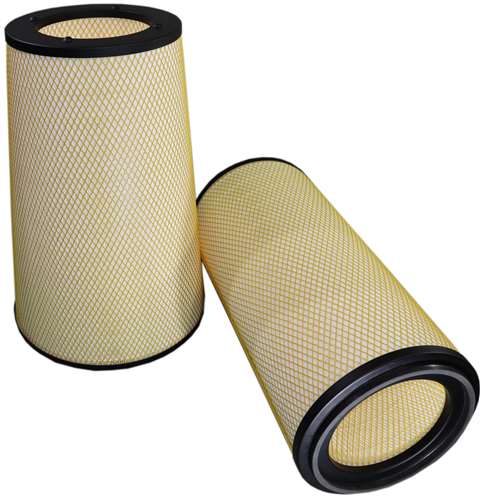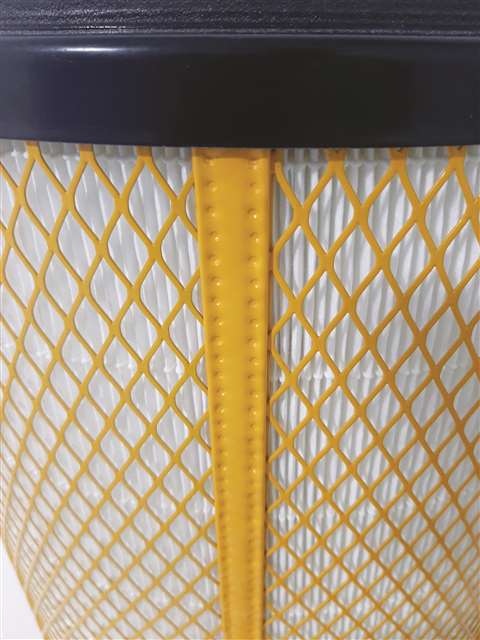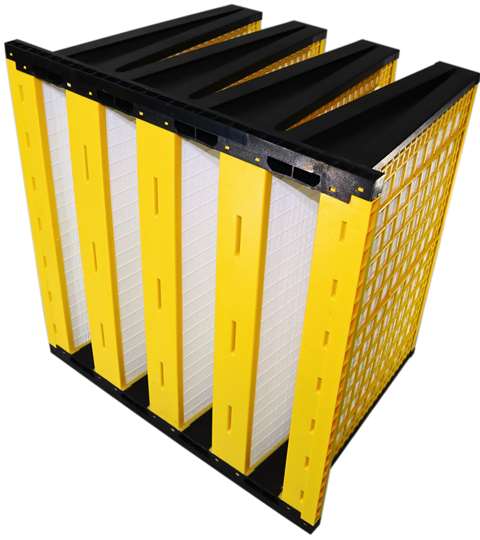The Evolution of Turbine Filtration
16 November 2022
 Filters designed with durable hydrophobic and oleophobic properties, such as the Clearcurrent Assure Hydroplus cartridge, remove problematic contaminants carried through to the turbine in liquid forms. (Photo: Parker)
Filters designed with durable hydrophobic and oleophobic properties, such as the Clearcurrent Assure Hydroplus cartridge, remove problematic contaminants carried through to the turbine in liquid forms. (Photo: Parker)
The cost of damage or an outage of a gas turbine can quickly rise into the millions. Contamination can both damage a turbine and reduce its performance. Operators recognize that filtration systems are needed to protect turbines, which are often installed in harsh environments. However, with today’s extremely high efficiency, precisely engineered gas turbines, protecting machines and their performance is more critical than ever. So as gas turbine technology has evolved, filtration systems have also kept in step.
The latest advanced GT technology achieves high levels of efficiency through a better understanding of heat transfer, higher firing temperatures and precise “super finish” aerodynamic designs. Design features include advanced blade aerodynamics, enhanced air cooling flow, improved design of hot gas path components to reduce temperature and stress gradients and upgraded thermal barrier coatings. The fine tuning of these machines and the super alloys they employ requires more rigorous protection from the damage finer particulates and contaminates in the inlet air flow can cause.
 The risk of rust is particularly high in areas where there are salt particles, high humidity and hydrogen sulfide from natural gas in the atmosphere. (Photo: Parker)
The risk of rust is particularly high in areas where there are salt particles, high humidity and hydrogen sulfide from natural gas in the atmosphere. (Photo: Parker)
Contaminants damage
Contaminants can include salt, dust, sand and moisture and a gas turbine filtration system often needs to handle some or all of them. Larger dust or sand particles can erode the special super alloys, finishes and coatings inside the compressor and turbine and may eventually lead to severe machine damage. Finer dust particles can stick to turbine blades, affecting operating aerodynamics, reducing turbine efficiencies and increasing operational costs.
Salt is one of the most troublesome contaminants for gas turbine operators. In the offshore industry and anywhere close to bodies of salt water, the damage to turbines can be swift and severe if it is not dealt with properly. Salt is hygroscopic, meaning it can absorb moisture from the air, and it can quickly move between dry, sticky and liquid forms. As well as adhering to turbine blades and affecting efficiency, salt can combine with fuel in hotter areas of the turbine to form sodium sulphate which reacts with turbine metal to cause accelerated corrosion.
Small droplets of moisture in the turbine inlet air stream will combine with dust to form mud which can block a filter. The size of these droplets means they can also work their way into the matrix of the filter media and get stuck. Moisture also causes quick changes in the physical state of hygroscopic salt particles from solid to liquid form, making them more challenging for the filtration system to handle.
 Powder coating the metal parts of the filter housing can enhance reliability and resilience to environmental factors. (Photos: Parker)
Powder coating the metal parts of the filter housing can enhance reliability and resilience to environmental factors. (Photos: Parker)
Filtration design considerations
One of the primary elements of a filtration system is the filtration media. With different contaminants to handle, large advanced gas turbines typically have multiple filtration stages with increasingly fine media to collect particles. This media is pleated into panels to maximize the filtration area and optimize filtration efficiency.
However, picking the right media for an installation site is only part of the story. If the filters are not designed and constructed to withstand the elements themselves, air can bypass the media, rendering it useless. Air will always take the path of least resistance and if it can get around the media, it will carry with it the contaminants and moisture the filters are there to stop from reaching the gas turbine. The result will be pitting and corrosion that will, over time, severely damage turbine performance and may eventually lead to catastrophic failures and outages.
To prevent air bypass, filter designs need to be robust. Using polyurethane (PU) flow technology in the filter construction will ensure complete encapsulation of the media pleats. In high-moisture environments, it may also make sense to use edge seal technology, which applies continuous hot-melt beads at the border of the pleats to act as a secondary reinforcement seal against the moisture.
Other considerations concerning filter construction include the risk of rust. The risk of rust is particularly high in areas where there are salt particles, high humidity and hydrogen sulfide from natural gas in the atmosphere. Sulfur dioxide emissions from diesel exhaust fumes in urban areas, volcanoes, springs, strong alkalis, plasters and cement from nearby industries that contain chlorides and sulfates, acid rainwater and cooling tower drift can all promote rusting. As such, it makes sense for the metal parts of the filter housing to be powder coated to enhance reliability and resilience to environmental factors. Waterproof coatings incorporating cross-linked materials will further increase the filter’s resilience to cracking, peeling, chipping and abrasion.
 Edge seal technology such as that used on Parker’s vCell filters incorporate continuous hot-melt beads at the border of the pleats to act as a secondary reinforcement seal in high-moisture environments. (Photo: Parker)
Edge seal technology such as that used on Parker’s vCell filters incorporate continuous hot-melt beads at the border of the pleats to act as a secondary reinforcement seal in high-moisture environments. (Photo: Parker)
When looking for a reliable filtration solution, operators should also look for units that include robust frames, the use of construction materials that do not crack or become brittle over time and media selection that is not prone to sudden blockages and pressure spikes.
Understanding the specs
The issue with filter ratings and specifications is that they are usually carried out in laboratory conditions which do not relate to the combination of true environmental factors gas turbine filters can face in the real world. From temperate climates to hot, dusty deserts, to areas with freezing temperatures, salt aerosols or high humidity, every gas turbine installation has unique environmental challenges. The only true measure of how good a filter is will be its performance on site. To this end, gas turbine operators should consider options that have had extended testing in real-world conditions, across sites that have similar elements to your site installation.
To best protect the remarkable performance of high-efficiency advanced gas turbines, filtration systems are also evolving. A filtration system is only as good as its weakest part. While the choice of media is important, there are many other factors in the design of filters that are required to ensure gas turbine performance is maintained, including construction, sealing, pleat design, treatments and coatings and choice of media, across multiple filtration stages.
About the author: Tim Nicholas is PowerGen Market Manager for the Gas Turbine Filtration Division of Parker Hannifin.
STAY CONNECTED




Receive the information you need when you need it through our world-leading magazines, newsletters and daily briefings.
POWER SOURCING GUIDE
The trusted reference and buyer’s guide for 83 years
The original “desktop search engine,” guiding nearly 10,000 users in more than 90 countries it is the primary reference for specifications and details on all the components that go into engine systems.
Visit Now
CONNECT WITH THE TEAM









